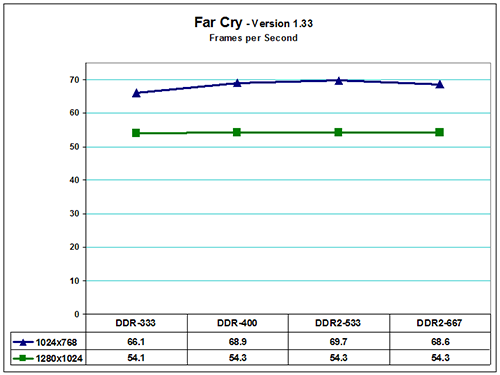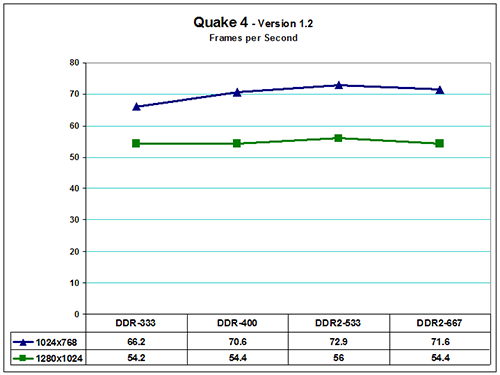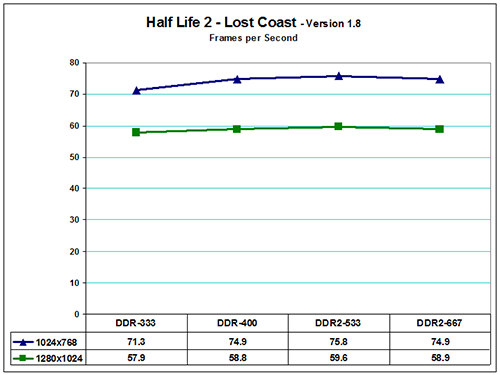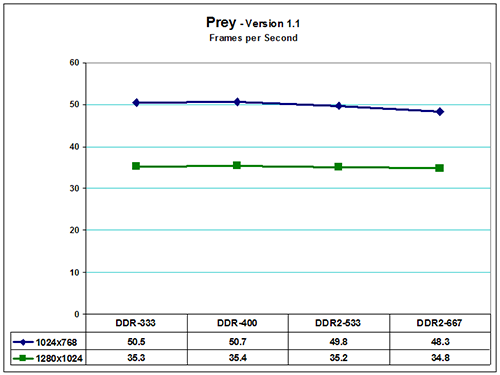ASRock 775Dual-VSTA: Does DDR2 matter?
by Gary Key on August 8, 2006 6:35 AM EST- Posted in
- Motherboards
Game Performance Comparison
While Sandra and Super Pi provide useful information on how memory performs without the influence of other components, our first round of real world tests has shown there is not a large difference in performance between DDR2 and DDR memory on this particular platform. However, our next set of real-world benchmarks consists of gaming benchmarks.
We utilize Far Cry, Half-Life 2 and Quake 4 in our normal memory testing because they are sensitive to memory changes. We are adding Prey and Serious Sam II to our benchmark mix because they are typically very GPU dependent and we will see the effects of our memory choices on these games. We tested at both 1024x768 and 1280x1024 at High Quality settings but without anti-aliasing or antistrophic filtering enabled. We feel like these settings are representative of a platform at this price point and believe most users would be utilizing a 17" or 19" monitor with this setup.





Our three memory sensitive games show a slight difference in results at 1024x768 but are GPU limited at 1280x1024 for all intents and purposes. The performance pattern is similar to the synthetic benchmarks with the DDR2-533 setting performing best overall. The DDR2-667 and DDR-400 configurations basically end in a tie with the DDR-333 finishing last. Our two GPU limited games actually favor the DDR-400 memory setup although the scores across the board are well within our margin of test error.
Overall, gaming performance is fine with low latency DDR-400 memory on this platform. Even DDR-333 provides for acceptable performance, particularly if you're looking to upgrade from an old socket A or 478 system. In that case, you might also want a new GPU, but we'll take a look at PCIe vs. AGP performance in part two of this series.
While Sandra and Super Pi provide useful information on how memory performs without the influence of other components, our first round of real world tests has shown there is not a large difference in performance between DDR2 and DDR memory on this particular platform. However, our next set of real-world benchmarks consists of gaming benchmarks.
We utilize Far Cry, Half-Life 2 and Quake 4 in our normal memory testing because they are sensitive to memory changes. We are adding Prey and Serious Sam II to our benchmark mix because they are typically very GPU dependent and we will see the effects of our memory choices on these games. We tested at both 1024x768 and 1280x1024 at High Quality settings but without anti-aliasing or antistrophic filtering enabled. We feel like these settings are representative of a platform at this price point and believe most users would be utilizing a 17" or 19" monitor with this setup.





Our three memory sensitive games show a slight difference in results at 1024x768 but are GPU limited at 1280x1024 for all intents and purposes. The performance pattern is similar to the synthetic benchmarks with the DDR2-533 setting performing best overall. The DDR2-667 and DDR-400 configurations basically end in a tie with the DDR-333 finishing last. Our two GPU limited games actually favor the DDR-400 memory setup although the scores across the board are well within our margin of test error.
Overall, gaming performance is fine with low latency DDR-400 memory on this platform. Even DDR-333 provides for acceptable performance, particularly if you're looking to upgrade from an old socket A or 478 system. In that case, you might also want a new GPU, but we'll take a look at PCIe vs. AGP performance in part two of this series.










55 Comments
View All Comments
shambf00 - Monday, December 4, 2006 - link
Gary, please, how were you able to change the memory ratio?I have DDR 400mhz on this motherboard with the E6300, however, the motherboard sees it as DDR 333mhz even after I set the speed manually.
Can you (or anyone else who knows about this) tell me where to change the memory ratio so my ram can run at it's normal speed?
Thanks!
lumbergeek - Friday, February 9, 2007 - link
The only way I was able to change the memory ratio (this board with E6300, 2GB Mushkin low-latency DDR400 and an AGP ATI 1650pro) was to play around with the manual setting for RAM and FSB - the board seems to select the multiplier on it's own. If anyone knows how to adjust it manually, I'd love to know about it myself!tomppi - Thursday, August 24, 2006 - link
..have had some 2-3-2-6-1 kingston memory for 2 years now (KHX3200AK2_1G)used to be on a ASUS A7N8X-E Deluxe. only did 2.5-3-3-12-1
now with the asrockdual-vsta i can't keep it stable unless i run at ~3-3-3-12-2 (400mhz)
why can't I even come close to the speeds shown in this article :(
GoatMonkey - Wednesday, August 9, 2006 - link
I have a possibly stupid question. Will this board work with only one stick of memory or do they need to be added in pairs. I have a single 1GB DDR400 stick in my Athlon XP3200 that would be nice to be able to use, but if I have to buy new memory anyway I might as well get the DDR2.Gary Key - Wednesday, August 9, 2006 - link
No Question is Stupid. :)However, sometimes my answers might appear that way. ;-)
The board works fine with a single stick of memory but you will be regulated to single channel operation. This places a 3%~7% performance penalty on most applications although you will need benchmarks to tell the difference in most cases.
johnsonx - Wednesday, August 9, 2006 - link
Perhaps it might be worthwhile to show performance numbers for the single-channel situation in one of the upcoming articles? I'm sure many people are in similar situations. My 754 machine just has a single 1Gb DDR400 stick as well, so if I were to consider a value Core 2 cpu & board combo (of the sort Fry's may offer in the coming months) I might want to continue using that memory if it will work and not completely cripple the performance.veryevilmike - Thursday, August 10, 2006 - link
Is the asrock 775-HDTV rev2 (using the ati xpress200 chipset) one of the budget boards on the review list? It is limited to single channel but was contemplating this as a stopgap for a few months until rd600 & co arrive, when the board would become a cheap htpc. its also one of the only uATX conroe boards available.All up, congrats on doing such a useful 'realistic' review early on in the piece - makes a nice change from all the super-expensive stuff that is not in the picture for 99% of people.
GoatMonkey - Wednesday, August 9, 2006 - link
Sounds good to me. I could go with that for a while and later upgrade to the DDR2 and new video card, and a better motherboard at some point after that. An e6600 should be available for around $350 (one of these days anyway), and then this board for under $75 or so. Roughly $400 to $425 for a significant upgrade and an easy path for other components sounds good to me.Sunrise089 - Wednesday, August 9, 2006 - link
Now after the most obvious subject line of all time, here's what I'm thinking:I continue to be impressed with Conroe's performance, but grow more and more dissapointed with Conroe's performance scaled to price. With s939 basically any price paid could get you very near FX-57 speeds. Cheap DFI Infinity board + Cheap Opteron 144 or a lucky 3000+ = 2.6+ghz on air with a good cooler. An FX-57 might hit 3.0ghz on air if you were very lucky.
Conroe doesn't seem to work that way. Sure the top 2 or 3 processors perform the same, give or take, but the lower cache processors loose a lot of performance (much more than the above mentioed Athlons). Then, getting a cheaper motherboard really lowers maximum overclock. Then high-performance memory costs a lot more, and probably adds more performance as well. Finally really cheap parts like this totally cripple performance.
I think as more people come to relize this we will see a reality check from the community, where many on the high end will end up with awesome Conroe systems, but many others will realize with their budgets a nicely upgraded s939 X2 system with their existing servicable DDR memory and a newly discounted X1900XT will be a better overall platform dollar for dollar. This user is certainly beginning to lean that way. And heck, by the time I have to upgrade for a second time Conroe should be available with a 1066mhz FSB anyways.
Paladin165 - Wednesday, August 9, 2006 - link
"the lower cache processors loose a lot of performance"Wheres your evidence for this? Hasn't it been established that the performance hit is around 3% on average? (http://www.anandtech.com/cpuchipsets/showdoc.aspx?...">http://www.anandtech.com/cpuchipsets/showdoc.aspx?...